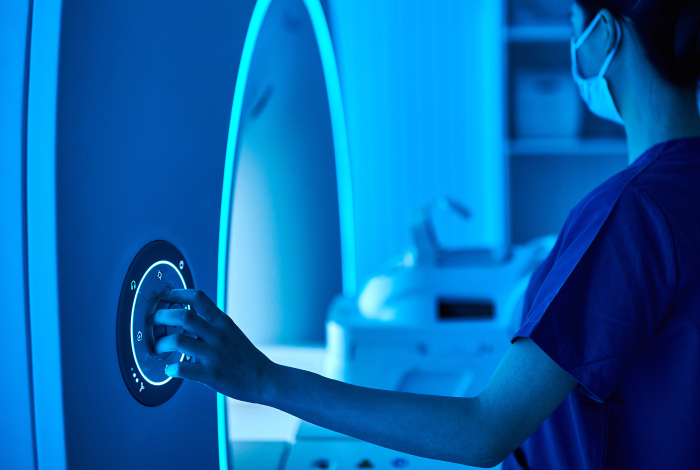Your PET-CT questions answered

Here are answers to the questions on your mind about this important imaging technology — and where you can access it.
What is a PET-CT scan?
A PET-CT scan combines two imaging technologies – Positron Emission Tomography (PET) and Computed Tomography (CT) – into one powerful tool.
The scan shows not only what your organs and tissues look like, but also how they behave, giving clear pictures of your body’s structure. The PET scan shows how those tissues and organs are functioning by detecting small changes in cellular activity. When these two scans are combined, they give doctors a complete picture, encompassing both structure and function. This information helps them stage the disease correctly and plan treatment more precisely.
What is a PET-CT scan used for?
PET-CT scans are most often used in cancer care, helping doctors to:
- Help identify whether a tumour is cancerous (benign or malignant).
- See how far the cancer has spread (staging).
- Check how well treatment is working in real time.
- Detect if the cancer has returned after treatment.
Beyond oncology, PET-CT scans are also valuable in cardiology (to assess heart muscle function) and neurology (to study conditions such as epilepsy, Alzheimer’s disease and other brain disorders).
How does a PET-CT scan work?
Before the scan, you’ll receive a small amount of a radiotracer, a harmless substance that travels through your body and highlights areas of high activity, such as rapidly growing cancer cells. As the PET-CT scanner moves slowly around you, it detects this activity and creates a series of detailed, 3D images of your body. The radiotracer naturally leaves your system within a few hours.
Is a PET-CT scan painful?
No. You will feel a pinprick from the IV insertion, but the actual scan is painless.
Will I feel the radiation?
No. You won’t feel the tracer or its effects.
How should I prepare for a PET-CT scan if I am diabetic?
Inform your care team about all medications and existing conditions like diabetes or infections, which can influence tracer absorption. Your care team will provide specific guidance about managing your glucose and medications beforehand. Always disclose this upfront.
Is a PET-CT scan safe?
Yes. The amount of radiation you’re exposed to during a PET-CT scan is small, similar to other diagnostic scans, and the procedure is considered safe for most patients. The radiotracer used breaks down quickly and leaves your body through urine. Your doctor will always weigh the benefits and any risks before recommending a PET-CT scan, ensuring it is the best choice for your situation.
What can I expect on the day?
The modern digital scanners used by Life Healthcare are designed for comfort, with shorter scan times and a calm, welcoming environment. Here’s what typically happens before, during and after a PET-CT scan.
How is PET-CT different from other scans?
While CT and MRI scans show the structure of your organs, PET-CT scans show how they’re functioning, providing early clues to disease even before structural changes occur. This means PET-CT can detect cancer or other abnormalities earlier and with greater accuracy, often leading to more effective and personalised treatment plans.
What are the benefits of digital PET-CT?*
- Sharper, high-resolution images that help doctors see details more clearly.
- Faster scan times, meaning shorter appointments and less time lying still.
- More accurate imaging, helping guide targeted treatments and monitor progress.
“Digital PET-CT offers higher sensitivity, improved image resolution and faster scan times, which can enable quicker and more accurate management plans, ultimately benefitting patients through timely and personalised treatment,” says Dr Bruce Young, nuclear physician at TheraMed Nuclear, in partnership with Life Healthcare.
Where can I get a PET-CT scan?
Access to PET-CT technology in South Africa has historically been limited, but this is changing. As of November 2025, PET-CT scanning is now available at Life Vincent Pallotti Hospital following the opening of its brand-new nuclear medicine unit.
This is Life Healthcare’s first nuclear medicine unit and only the second private PET-CT scanner in the Western Cape. The new unit, developed in collaboration with GE HealthCare, offers PET-CT scans, with SPECT-CT services set to launch in early 2026. Both scans combine two types of imaging, helping doctors spot abnormalities sooner and target treatments more accurately.
Life Healthcare also offer PET-CT scans in Gauteng in partnership with Theramed Nuclear and will soon be launching a PET-CT scanner in Kwa-Zulu Natal.
To get a PET-CT scan, consult your physician or oncologist for a referral. If you have medical aid, ensure you obtain an authorisation number prior to the scan. Download our patient brochure to keep and refer back to when you need it.
*It’s important to note that while PET-CT scans offer valuable insights, they are not definitive alone and are typically used alongside other diagnostic tests and clinical evaluations for a comprehensive assessment. Speak to your doctor to learn more.
Disclaimer: The information is shared on condition that readers will make their own determination, including seeking advice from a healthcare professional. E&OE. Life Healthcare Group Ltd does not accept any responsibility for any loss or damage suffered by the reader as a result of the information provided.

